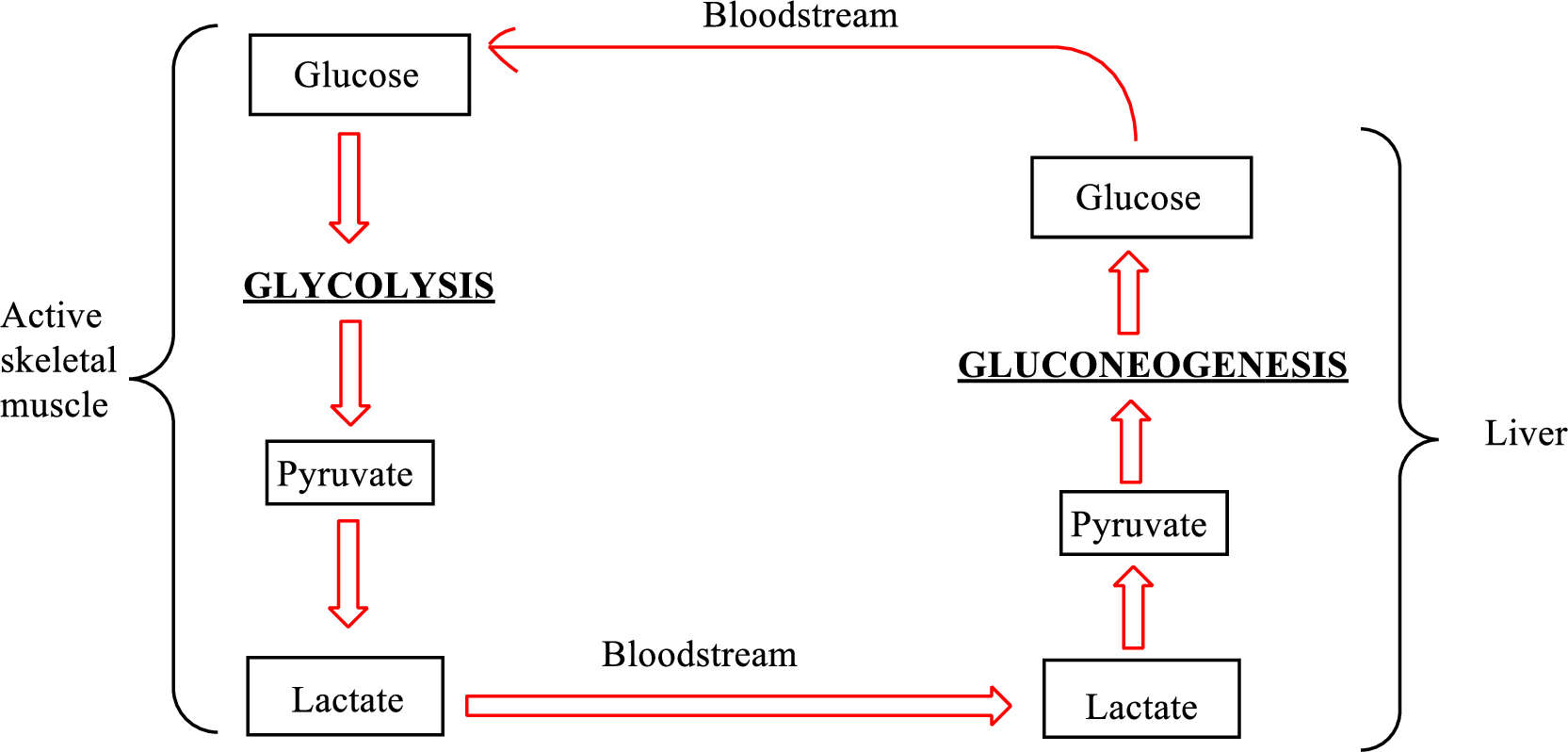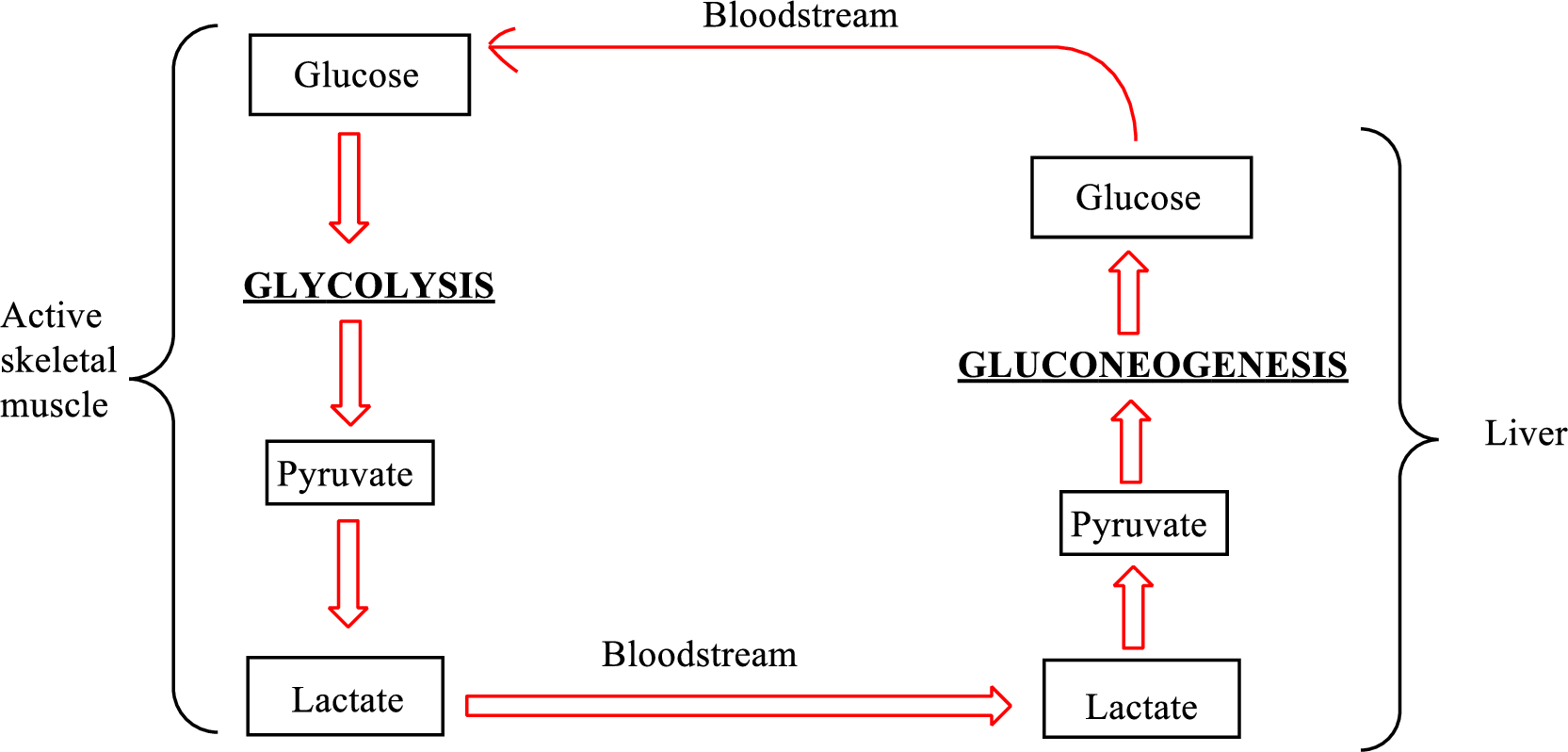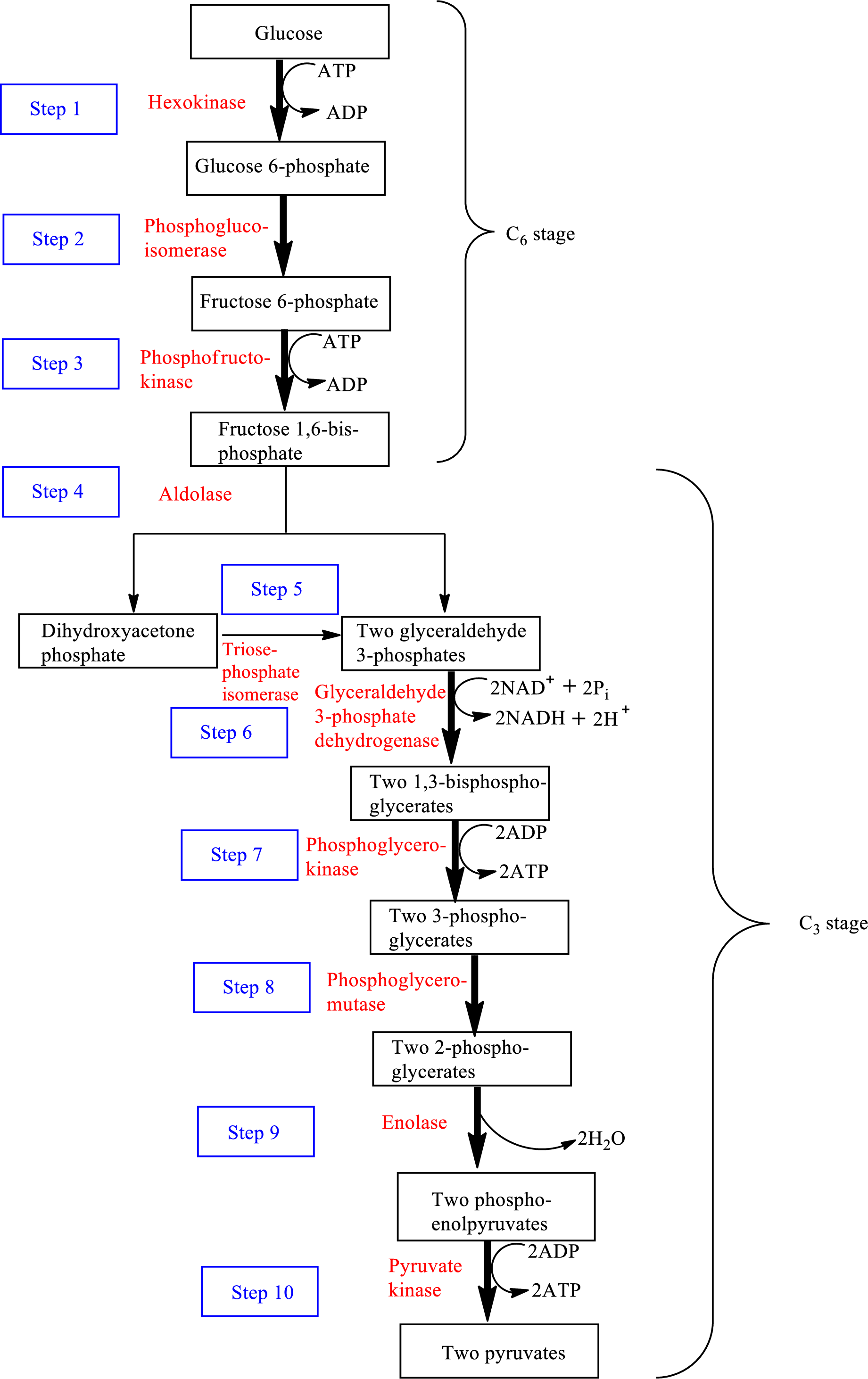
Concept explainers
(a)
Interpretation: To indicate whether pyruvate is involved in (1) the pentose phosphate pathway, (2) the Cori cycle, (3) glycolysis, or (4) lactate fermentation.
Concept introduction: The pentose phosphate pathway is defined as the metabolic pathway in which NADPH,
Glucose is converted to pyruvate by glycolysis metabolic pathway; pyruvate is further converted to lactate in the skeletal muscle cells by anaerobic reactions. The lactate is diffused into the bloodstream, by which it is transported to the liver. Lactate is reconverted to pyruvate. Gluconeogenesis metabolic pathway uses this pyruvate to synthesize glucose in the liver cells. Glucose is diffused into the bloodstream and is transported back to the active skeletal muscle cells. This cycle is known as the Cori cycle.
Glycolysis is the metabolic pathway that breaks down a glucose molecule and converts it into two pyruvate molecules along with the production of two ATP molecules and NADH coenzymes.
Fermentation is defined as the biochemical anaerobic process by which NADH is oxidized to
Pyruvate
(a)
Answer to Problem 24.106EP
Pyruvate is associated with (2) the Cori cycle, (3) glycolysis, and (4) the lactate fermentation.
Explanation of Solution
An overview of the Cori cycle is as follows:

Lactate is converted to pyruvate in the liver and pyruvate is converted to lactate in the active skeletal muscle cells. Therefore, pyruvate is associated with the Cori cycle.
The net overall equation for the glycolysis process is as follows:
Therefore, pyruvate is the final product of glycolysis metabolic pathway.
Pyruvate is converted to lactate under oxygen-poor conditions by lactate dehydrogenase enzymes in the human body. This anaerobic reduction of pyruvate to form lactate by enzymes is called lactate fermentation. The
Therefore, pyruvate is associated with lactate fermentation.
(b)
Interpretation: To indicate whether
Concept introduction: The pentose phosphate pathway is defined as the metabolic pathway in which NADPH,
Glucose is converted to pyruvate by glycolysis metabolic pathway; pyruvate is further converted to lactate in the skeletal muscle cells by anaerobic reactions. The lactate is diffused into the bloodstream, by which it is transported to the liver. Lactate is reconverted to pyruvate. Gluconeogenesis metabolic pathway uses this pyruvate to synthesize glucose in the liver cells. Glucose is diffused into the bloodstream and is transported back to the active skeletal muscle cells. This cycle is known as the Cori cycle.
Glycolysis is the metabolic pathway that breaks down a glucose molecule and converts it into two pyruvate molecules along with the production of two ATP molecules and NADH coenzymes.
Pyruvate is converted to lactate under oxygen-poor conditions by lactate dehydrogenase enzymes in the human body. This anaerobic reduction of pyruvate to form lactate by enzymes is called lactate fermentation.
Nicotinamide adenine dinucleotide phosphate is associated with the
(b)
Answer to Problem 24.106EP
Explanation of Solution
The overall net equation for the pentose phosphate pathway is as follows:
Hence,
(c)
Interpretation: To indicate whether glucose is involved in (1) the pentose phosphate pathway, (2) the Cori cycle, (3) glycolysis, or (4) lactate fermentation.
Concept introduction: The pentose phosphate pathway is defined as the metabolic pathway in which NADPH,
Glucose is converted to pyruvate by glycolysis metabolic pathway; pyruvate is further converted to lactate in the skeletal muscle cells by anaerobic reactions. The lactate is diffused into the bloodstream, by which it is transported to the liver. Lactate is reconverted to pyruvate. Gluconeogenesis metabolic pathway uses this pyruvate to synthesize glucose in the liver cells. Glucose is diffused into the bloodstream and is transported back to the active skeletal muscle cells. This cycle is known as the Cori cycle.
Glycolysis is the metabolic pathway that breaks down a glucose molecule and converts it into two pyruvate molecules along with the production of two ATP molecules and NADH coenzymes.
Pyruvate is converted to lactate under oxygen-poor conditions by lactate dehydrogenase enzymes in the human body. This anaerobic reduction of pyruvate to form lactate by enzymes is called lactate fermentation.
(c)
Answer to Problem 24.106EP
Glucose is associated with (1) the pentose phosphate pathway, (2) the Cori cycle, and (3) glycolysis.
Explanation of Solution
The overall net equation for the pentose phosphate pathway is as follows:
Glucose is present in the form of
An overview of the Cori cycle is as follows:

The net overall equation for the glycolysis process is as follows:
Glucose is encountered as a reactant in is the glycolysis metabolic pathway. Therefore, glucose is involved in the pentose phosphate pathway, the Cori cycle, and (3) glycolysis.
(d)
Interpretation: To indicate whether
Concept introduction: The pentose phosphate pathway is defined as the metabolic pathway in which NADPH,
Glucose is converted to pyruvate by glycolysis metabolic pathway; pyruvate is further converted to lactate in the skeletal muscle cells by anaerobic reactions. The lactate is diffused into the bloodstream, by which it is transported to the liver. Lactate is reconverted to pyruvate. Gluconeogenesis metabolic pathway uses this pyruvate to synthesize glucose in the liver cells. Glucose is diffused into the bloodstream and is transported back to the active skeletal muscle cells. This cycle is known as the Cori cycle.
Glycolysis is the metabolic pathway that breaks down a glucose molecule and converts it into two pyruvate molecules along with the production of two ATP molecules and NADH coenzymes.
Pyruvate is converted to lactate under oxygen-poor conditions by lactate dehydrogenase enzymes in the human body. This anaerobic reduction of pyruvate to form lactate by enzymes is called lactate fermentation.
(d)
Answer to Problem 24.106EP
Explanation of Solution
The overall net equation for the pentose phosphate pathway is as follows:
An overview of the glycolysis metabolic pathway is as follows:

Isomerization is the second step in the glycolysis process.
Want to see more full solutions like this?
Chapter 24 Solutions
GENERAL,ORGANIC,+BIO.CHEM.-MINDTAP
- Assign all the protonsarrow_forwardAssign all the carbonsarrow_forward9 7 8 C 9 8 200 190 B 5 A -197.72 9 8 7 15 4 3 0: ང་ 200 190 180 147.52 134.98 170 160 150 140 130 120 110 100 90 90 OH 10 4 3 1 2 -143.04 140. 180 170 160 150 140 130 120 110 100 90 CI 3 5 1 2 141.89 140.07 200 190 180 170 160 150 140 130 120 110 100 ៖- 90 129. 126.25 80 70 60 -60 50 40 10 125.19 -129.21 80 70 3.0 20 20 -8 60 50 10 ppm -20 40 128.31 80 80 70 60 50 40 40 -70.27 3.0 20 10 ppm 00˚0-- 77.17 30 20 20 -45.36 10 ppm -0.00 26.48 22.32 ―30.10 ―-0.00arrow_forward
- Assign all the carbonsarrow_forwardC 5 4 3 CI 2 the Righ B A 5 4 3 The Lich. OH 10 4 5 3 1 LOOP- -147.52 T 77.17 -45.36 200 190 180 170 160 150 140 130 120 110 100 90 80 70 60 50 40 30 20 10 ppm B -126.25 77.03 200 190 180 170 160 150 140 130 120 110 100 90 80 70 60 50 40 30 20 10 ppm 200 190 180 170 160 150 140 130 120 110 100 90 80 TO LL <-50.00 70 60 50 40 30 20 10 ppm 45.06 30.18 -26.45 22.36 --0.00 45.07 7.5 1.93 2.05 -30.24 -22.36 C A 7 8 5 ° 4 3 7.5 7.0 6.5 6.0 5.5 5.0 4.5 4.0 3.5 3.0 2.5 2.0 1.5 1.0 ppm 9 8 5 4 3 ཡི་ OH 10 2 7.5 7.0 6.5 6.0 5.5 5.0 4.5 4.0 3.5 3.0 2.5 2.0 1.5 5 4 3 2 that th 7 I 7.0 6.5 6.0 5.5 5.0 4.5 4.0 3.5 3.0 2.5 2.0 1.5 115 2.21 4.00 1.0 ppm 6.96 2.76 5.01 1.0 ppm 6.30 1.00arrow_forwardCurved arrows were used to generate the significant resonance structure and labeled the most significant contribute. What are the errors in these resonance mechanisms. Draw out the correct resonance mechanisms with an brief explanation.arrow_forward
- What are the: нсе * Moles of Hice while given: a) 10.0 ml 2.7M ? 6) 10.ome 12M ?arrow_forwardYou are asked to use curved arrows to generate the significant resonance structures for the following series of compounds and to label the most significant contributor. Identify the errors that would occur if you do not expand the Lewis structures or double-check the mechanisms. Also provide the correct answers.arrow_forwardhow to get limiting reactant and % yield based off this data Compound Mass 6) Volume(mL Ben zaphone-5008 ne Acetic Acid 1. Sam L 2-propanot 8.00 Benzopin- a col 030445 Benzopin a Colone 0.06743 Results Compound Melting Point (°c) Benzopin acol 172°c - 175.8 °c Benzoping to lone 1797-180.9arrow_forward
- Assign ALL signals for the proton and carbon NMR spectra on the following pages.arrow_forward7.5 1.93 2.05 C B A 4 3 5 The Joh. 9 7 8 1 2 7.5 7.0 6.5 6.0 5.5 5.0 4.5 4.0 3.5 3.0 2.5 2.0 1.5 1.0 ppm 9 7 8 0.86 OH 10 4 3 5 1 2 7.5 7.0 6.5 6.0 5.5 5.0 4.5 4.0 3.5 3.0 2.5 2.0 1.5 1.0 ppm 9 7 8 CI 4 3 5 1 2 7.0 6.5 6.0 5.5 5.0 4.5 4.0 3.5 3.0 2.5 2.0 2.21 4.00 1.5 2.00 2.07 1.0 ppm 2.76arrow_forwardAssign the functional group bands on the IR spectra.arrow_forward
 Chemistry for Today: General, Organic, and Bioche...ChemistryISBN:9781305960060Author:Spencer L. Seager, Michael R. Slabaugh, Maren S. HansenPublisher:Cengage Learning
Chemistry for Today: General, Organic, and Bioche...ChemistryISBN:9781305960060Author:Spencer L. Seager, Michael R. Slabaugh, Maren S. HansenPublisher:Cengage Learning General, Organic, and Biological ChemistryChemistryISBN:9781285853918Author:H. Stephen StokerPublisher:Cengage Learning
General, Organic, and Biological ChemistryChemistryISBN:9781285853918Author:H. Stephen StokerPublisher:Cengage Learning Organic And Biological ChemistryChemistryISBN:9781305081079Author:STOKER, H. Stephen (howard Stephen)Publisher:Cengage Learning,
Organic And Biological ChemistryChemistryISBN:9781305081079Author:STOKER, H. Stephen (howard Stephen)Publisher:Cengage Learning,- Chemistry: Matter and ChangeChemistryISBN:9780078746376Author:Dinah Zike, Laurel Dingrando, Nicholas Hainen, Cheryl WistromPublisher:Glencoe/McGraw-Hill School Pub Co
 Chemistry In FocusChemistryISBN:9781305084476Author:Tro, Nivaldo J., Neu, Don.Publisher:Cengage Learning
Chemistry In FocusChemistryISBN:9781305084476Author:Tro, Nivaldo J., Neu, Don.Publisher:Cengage Learning Introduction to General, Organic and BiochemistryChemistryISBN:9781285869759Author:Frederick A. Bettelheim, William H. Brown, Mary K. Campbell, Shawn O. Farrell, Omar TorresPublisher:Cengage Learning
Introduction to General, Organic and BiochemistryChemistryISBN:9781285869759Author:Frederick A. Bettelheim, William H. Brown, Mary K. Campbell, Shawn O. Farrell, Omar TorresPublisher:Cengage Learning





